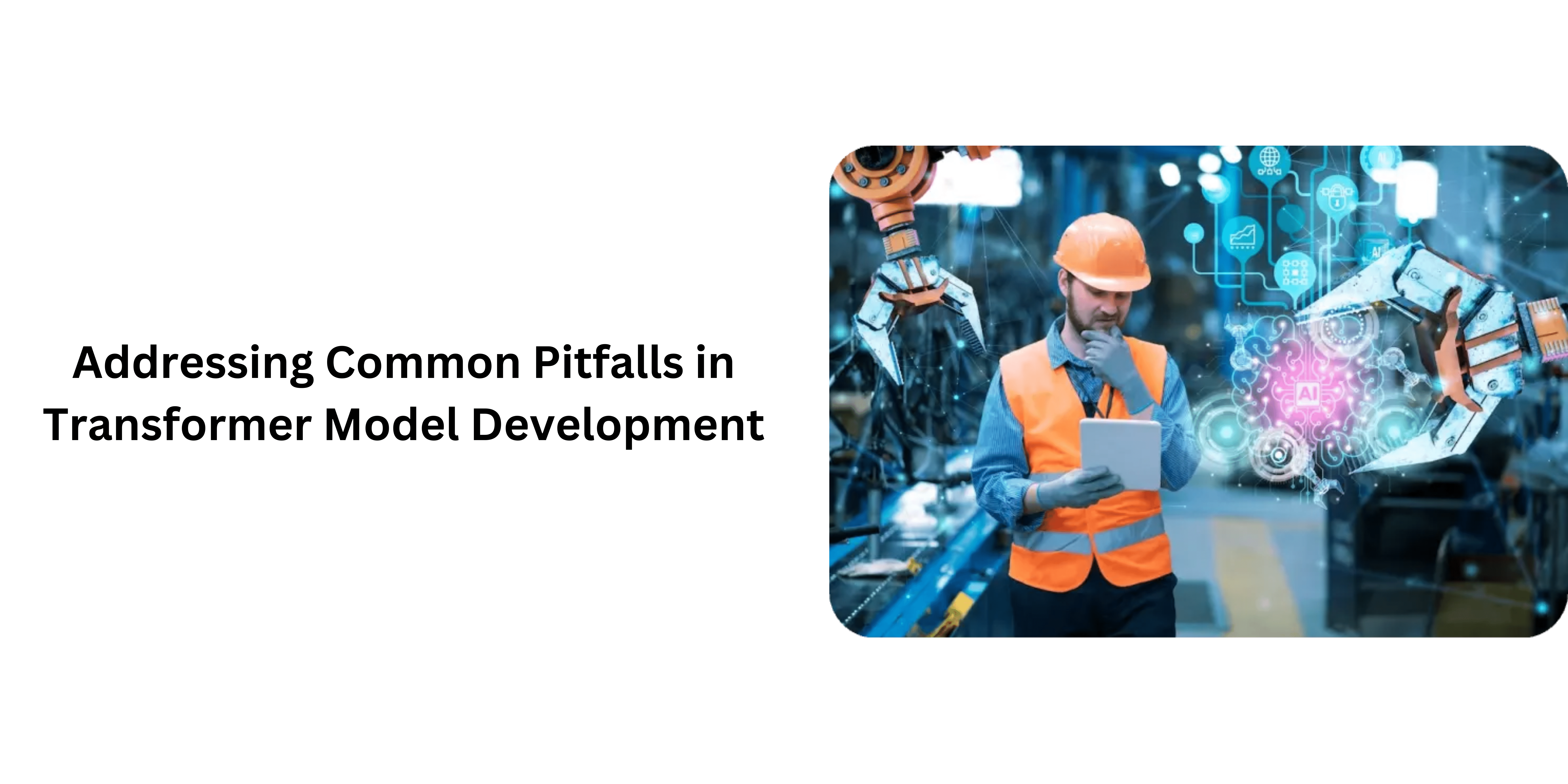In the rapidly evolving landscape of natural language processing and machine learning, transformer models have emerged as powerful tools, demonstrating remarkable capabilities in various applications. However, with great power comes the challenge of navigating through the intricate development process, where developers often encounter common pitfalls that can hinder the model’s effectiveness. This troubleshooting guide aims to address these challenges comprehensively, offering insights into mitigating issues related to data preprocessing, training dynamics, attention mechanisms, and deployment.
As transformer models become integral components in cutting-edge AI systems, understanding and overcoming obstacles in their development is crucial for achieving optimal performance. By delving into the nuances of issues such as overfitting, memory constraints, and transfer learning complexities, this guide equips practitioners with a holistic approach to troubleshoot and enhance the robustness of their transformer models. Whether you’re a seasoned developer or a newcomer to transformer architectures, this guide provides valuable strategies to elevate your understanding and proficiency in overcoming common hurdles in transformer model development.
Common Pitfalls in Data Preprocessing for Transformers
Data preprocessing is a critical phase in the development of transformer models, and overlooking key considerations can lead to significant performance issues. One common pitfall lies in inadequate handling of tokenization, where the input data is split into smaller units or tokens. If not done carefully, this process can result in information loss or disrupt the integrity of the input sequences, negatively impacting the model’s ability to understand and generalize patterns.
Another challenge arises from the handling of missing or noisy data. Transformers are sensitive to inconsistencies in input sequences, and incomplete or erroneous data can introduce biases and hinder the model’s learning process. It is essential to implement robust strategies for imputing missing values and addressing outliers to ensure the model’s robustness to real-world data scenarios.
Sequence length variability poses yet another pitfall. Inconsistent sequence lengths in the input data can disrupt the training process and lead to memory-related issues during model execution. Implementing effective padding or truncation strategies is crucial to maintain uniformity in sequence lengths without sacrificing essential information.
Furthermore, encoding categorical variables requires careful consideration. Inadequate encoding schemes may introduce spurious relationships or distort the underlying patterns in the data. Selecting appropriate encoding methods and handling categorical features judiciously is essential for maintaining the integrity of the input information.
In summary, addressing common pitfalls in data preprocessing for transformer model development services involves meticulous attention to tokenization, handling missing or noisy data, managing sequence length variability, and appropriately encoding categorical variables. By navigating these challenges thoughtfully, developers can lay a solid foundation for their transformer models, enabling them to extract meaningful insights and perform effectively across diverse datasets.
Overfitting and Underfitting: Strategies for Finding the Right Balance
Overfitting and underfitting are perennial challenges in machine learning, including transformer model development. Striking the right balance between these two extremes is crucial for achieving optimal model performance and generalization to unseen data.
Overfitting occurs when a model learns the training data too well, capturing noise and anomalies that do not generalize to new, unseen data. This can result in poor performance on real-world scenarios. On the other hand, underfitting occurs when the model is too simplistic, failing to capture the underlying patterns in the training data, and therefore performing poorly on both the training and unseen data.
To address overfitting, regularization techniques such as dropout and weight decay can be employed. These methods introduce randomness during training, preventing the model from relying too heavily on specific patterns present in the training data. Additionally, early stopping can be applied to halt the training process when performance on a validation set ceases to improve, preventing the model from overlearning the training data.
Conversely, to mitigate underfitting, model complexity can be increased by adding layers, neurons, or employing more sophisticated architectures. Ensuring that the model has enough capacity to capture the underlying patterns in the data is essential.
Regular monitoring of model performance on both training and validation sets is crucial. A well-balanced model achieves low training error without sacrificing performance on new, unseen data. The use of cross-validation, where the dataset is split into multiple folds for training and validation, aids in robustly assessing the model’s generalization capabilities.
In essence, navigating the trade-off between overfitting and underfitting requires a nuanced understanding of the data, thoughtful architecture design, and the application of appropriate regularization techniques. Finding the right balance ensures that transformer models generalize well and perform reliably across diverse datasets.
Dealing with Vanishing and Exploding Gradients in Transformers
Dealing with vanishing and exploding gradients is a crucial aspect of training transformer models, as these issues can significantly impede convergence and hinder the learning process. The vanishing gradient problem occurs when gradients become too small during backpropagation, leading to minimal weight updates and slow or stalled learning. Conversely, the exploding gradient problem involves excessively large gradients, causing numerical instability and unpredictable model behavior.
One effective strategy to mitigate vanishing gradients in custom transformer model development is the use of activation functions that promote the flow of gradients through the network. Rectified Linear Unit (ReLU) and variants, such as Leaky ReLU, are popular choices, as they allow positive gradients to pass through while mitigating the vanishing gradient problem. Additionally, normalization techniques like batch normalization can stabilize training by maintaining consistent activations and gradients throughout the layers.
To address exploding gradients, gradient clipping is a widely employed technique. It involves setting a threshold beyond which gradients are scaled down, preventing them from reaching extreme values that could lead to numerical instability. This ensures a more stable training process and helps avoid divergence.
Careful initialization of model weights, such as using techniques like Xavier or He initialization, can also contribute to mitigating both vanishing and exploding gradient issues. These initialization methods help balance the scale of weights, providing a more stable starting point for training.
Furthermore, choosing an appropriate optimizer, such as Adam or RMSprop, can contribute to gradient stability. Adaptive optimizers adjust learning rates dynamically based on the historical behavior of gradients, reducing the likelihood of vanishing or exploding gradients.
In summary, addressing vanishing and exploding gradients in transformers involves a combination of activation functions, normalization techniques, gradient clipping, weight initialization strategies, and careful optimizer selection. By incorporating these strategies, developers can foster stable and efficient training, enhancing the overall performance of transformer models.
Hyperparameter Tuning: Optimizing Model Performance
Hyperparameter tuning is a critical step in the development of transformer models, as it involves optimizing various parameters that are not learned during the training process. These hyperparameters significantly impact the model’s performance and generalization capabilities. Efficient tuning helps strike a balance between underfitting and overfitting, ensuring optimal performance across diverse datasets.
One common hyperparameter is the learning rate, which governs the step size during gradient descent. A carefully chosen learning rate can expedite convergence without causing divergence. Grid search or randomized search methods are often employed to systematically explore different learning rate values and identify the most effective one for the specific task.
Batch size is another crucial hyperparameter affecting the model’s training dynamics. Smaller batch sizes may offer better generalization, but they can also increase training time. Experimentation with different batch sizes helps find the optimal trade-off between training efficiency and model performance.
The number of layers, attention heads, and hidden units in the transformer architecture also play pivotal roles. These hyperparameters influence the model’s capacity to capture intricate patterns in the data. Techniques like grid search or Bayesian optimization can be applied to search through the hyperparameter space and identify the configuration that maximizes performance.
Regularization hyperparameters, such as dropout rates, weight decay, and attention dropout, contribute to preventing overfitting. Careful tuning of these parameters is essential to strike the right balance between model complexity and generalization.
In summary, hyperparameter tuning involves a systematic exploration of the hyperparameter space to optimize the model’s performance. Whether using manual tuning, grid search, or more advanced techniques, finding the right combination of hyperparameter values is crucial for developing transformer models that generalize well and excel in a variety of tasks.
Understanding and Addressing Attention Mechanism Issues
Attention mechanisms are pivotal components in transformer models, enabling them to selectively focus on different parts of input sequences during processing. However, understanding and addressing attention mechanism issues is essential for optimizing model performance.
One common issue is attention dropout, where certain positions or tokens receive disproportionately low attention weights during training. This can lead to information loss and impact the model’s ability to capture long-range dependencies. Techniques like residual connections and layer normalization help alleviate attention dropout, providing more stable and robust attention patterns.
Another challenge is the presence of attention biases, where the model exhibits a preference for specific positions in the input sequence. This bias can result in suboptimal performance, especially when dealing with sequences of varying lengths. Techniques like relative positional encoding and learned position embeddings help mitigate these biases, enabling the model to better adapt to different sequence lengths.
Handling attention across multiple heads is crucial for effective modeling. In some cases, attention heads may become redundant or overly specialized, limiting the model’s ability to capture diverse patterns. Techniques such as head pruning or attention head regularization can be employed to encourage diversity among attention heads, enhancing the overall representational capacity.
Furthermore, in transformer model optimization, attention mechanisms may struggle with capturing global context in very long sequences. Hierarchical attention mechanisms or sparse attention patterns are strategies that can be explored to address this limitation, facilitating the modeling of dependencies across distant parts of the input.
In conclusion, understanding and addressing attention mechanism issues involve a combination of architectural enhancements and regularization techniques. By refining attention mechanisms to overcome dropout, biases, and redundancy, developers can ensure that transformer models effectively capture and utilize information from input sequences, resulting in improved performance across a range of tasks.
Handling Outliers and Anomalies in Transformer Input Data
Handling outliers and anomalies in transformer input data is crucial to ensure robust and reliable model performance, as these irregularities can significantly impact the learning process and the model’s ability to generalize. Outliers, which are data points significantly different from the majority of the dataset, and anomalies, which are unexpected patterns or deviations, can introduce noise and distort the learned representations.
One effective strategy is preprocessing data to identify and handle outliers. Robust statistical methods, such as the interquartile range (IQR) or Z-score, can be applied to detect and filter out extreme values. Imputing or removing outlier-affected instances during preprocessing prevents the model from being disproportionately influenced by these atypical data points.
Additionally, employing data augmentation techniques can help the transformer model become more robust to anomalies. Augmentation involves introducing variations to the input data, such as introducing noise or perturbations, to expose the model to diverse scenarios. This can improve the model’s resilience to unexpected patterns and enhance its ability to generalize to unseen instances.
Furthermore, outlier-aware loss functions can be used during training to down weight the impact of outliers on the model’s learning. These loss functions assign lower weights to instances with outlier characteristics, ensuring that the model focuses more on the majority of the data.
Regular monitoring of model predictions during training and validation stages is essential for detecting anomalies that may arise in real-world scenarios. Techniques such as anomaly detection algorithms or outlier analysis can be employed to identify and handle unexpected patterns during both training and deployment.
In conclusion, handling outliers and anomalies in transformer input data involves a combination of preprocessing techniques, data augmentation, and outlier-aware training strategies. By addressing these challenges, developers can enhance the robustness of transformer models and ensure their effectiveness across diverse and real-world datasets.
Exploring Strategies to Mitigate the Impact of Imbalanced Datasets
Mitigating the impact of imbalanced datasets is a critical concern in transformer model development, as it directly affects the model’s ability to accurately learn and generalize from minority class instances. Imbalanced datasets, where one class significantly outnumbers the others, can lead to biased models that struggle to properly recognize and predict minority class samples. Several strategies can be explored to address this issue and ensure fair and effective learning:
Data Resampling
This involves either oversampling the minority class, under sampling the majority class, or a combination of both. This helps balance the class distribution in the training data and allows the model to give equal consideration to all classes.
Class-Weighted Loss Functions
Adjusting the loss function by assigning higher weights to minority class samples ensures that the model pays more attention to these instances during training. This helps in mitigating the impact of imbalanced class distribution.
Synthetic Data Generation
Techniques like data augmentation or the introduction of synthetic samples for the minority class can help improve the model’s exposure to underrepresented instances, enabling better generalization.
Ensemble Methods
Combining the predictions of multiple models, especially those trained on differently balanced subsets, can lead to more robust and unbiased predictions. Ensemble methods help mitigate the impact of imbalanced datasets by leveraging diverse model perspectives.
Transfer Learning and Pre-training
Leveraging pre-trained models on large and diverse datasets before fine-tuning on imbalanced data can enhance the model’s ability to generalize, even in the presence of imbalances.
By carefully implementing these strategies, developers can address the challenges posed by imbalanced datasets and foster the development of transformer models that are more equitable and performant across all classes.
Memory Constraints: Efficient Memory Usage in Transformer Models
Efficient memory usage is a critical consideration in developing transformer models, particularly due to their inherent complexity and resource-intensive nature. Memory constraints can arise during both training and inference, and addressing these challenges is essential for deploying transformer models in real-world scenarios.
One approach to handle memory constraints is model optimization, including model integration services. This involves reducing the model’s size by employing techniques such as model pruning, quantization, or knowledge distillation. Model pruning selectively removes less influential parameters, while quantization reduces the precision of weights and activations, effectively decreasing memory requirements. Knowledge distillation transfers knowledge from a larger, pre-trained model to a smaller one, preserving performance while reducing memory footprint.
Additionally, sequence length management is crucial, especially when dealing with long input sequences. Techniques like attention pooling or hierarchical attention mechanisms can be employed to selectively attend to relevant parts of the input, reducing the overall memory requirements.
During training, gradient checkpointing is a useful strategy. This technique trades compute efficiency for memory efficiency by recomputing intermediate activations during backpropagation, reducing the need to store all activations in memory.
Furthermore, leveraging mixed-precision training, where certain computations are performed in lower-precision formats, can significantly reduce memory usage without compromising model accuracy.
In deployment scenarios, model quantization and compression techniques become particularly relevant. Quantizing the model to lower precision, employing model sparsity, or using specialized hardware accelerators can further optimize memory usage.
In summary, addressing memory constraints in transformer models involves a combination of model optimization techniques, sequence length management, and leveraging specialized training and deployment strategies. By carefully considering and implementing these approaches, developers can ensure efficient memory usage while preserving the performance of transformer models across a variety of applications.
Debugging Tokenization Problems in Transformer Architectures
Debugging tokenization problems in transformer architectures is crucial for ensuring accurate and effective model training. Tokenization, the process of breaking down text into smaller units or tokens, plays a fundamental role in transformer models, and issues in this phase can lead to performance degradation. Here are strategies for identifying and addressing tokenization problems:
Tokenization Inspection
Begin by thoroughly examining the tokenization process. Visualize tokenized outputs and compare them with the original text to identify discrepancies. This can be crucial for understanding how the model interprets and processes input sequences.
Tokenization Libraries
Ensure that the tokenization libraries being used are consistent across training and inference. Different tokenization libraries might tokenize text differently, leading to discrepancies between the training and deployment phases. Maintaining consistency helps avoid unexpected issues.
Special Characters and Punctuation Handling
Pay attention to how special characters and punctuation are tokenized. Inconsistent handling of these elements can impact model performance, especially in tasks requiring a nuanced understanding of language.
Vocabulary Mismatch
Tokenization relies on pre-defined vocabularies. Issues can arise if the model encounters words or subwords during deployment that were not present in the training vocabulary. This can be addressed by updating the vocabulary or employing subword tokenization methods.
Segmentation Errors
For tasks involving multiple segments or sentences, ensure that the model correctly handles segmentation. Errors in segment boundaries can lead to misinterpretation of the input context.
Handling Out-of-Vocabulary (OOV) Tokens
Implement robust strategies for handling OOV tokens during inference, as encountering previously unseen words can disrupt tokenization. Techniques such as subword tokenization or using a fall-back mechanism can be effective.
By systematically examining and addressing these aspects of tokenization, developers can enhance the reliability and accuracy of transformer architectures, ensuring that the models perform as intended across diverse inputs and real-world scenarios.
Coping with Sequence Length Variability in Input Data
Coping with sequence length variability in input data is a common challenge in developing transformer models, as these architectures typically expect fixed-length input sequences. Variability in sequence lengths can lead to memory issues during training and inference. Here are strategies to effectively handle this challenge:
Padding and Truncation
One straightforward approach is to pad shorter sequences with a special token or truncate longer sequences to a predefined maximum length. While this ensures uniformity, it introduces the risk of losing information in truncated sequences or wasting computation on padded tokens.
Dynamic Padding
Employ dynamic padding, where sequences are padded to the length of the longest sequence within a batch. This minimizes padding for individual sequences, optimizing memory usage.
Bucketing and Batching
Group sequences into buckets based on their lengths and then form batches from these buckets. This way, sequences within a batch are of similar lengths, reducing the overall amount of padding needed.
Attention Masking
Leverage attention masking to indicate which positions in the input sequence are meaningful and which are padded. This way, the model can focus on relevant information and ignore padded tokens during training.
Positional Embeddings
Use positional embeddings to provide the model with information about the positions of tokens within a sequence. This helps the model understand the sequential order, even in the presence of padding or truncated sequences.
Hierarchical Models
Explore hierarchical or segment-level models where the input is processed in chunks or segments. This can be beneficial when dealing with very long documents or sequences.
By employing a combination of these strategies, developers can effectively cope with sequence length variability, allowing transformer models to handle diverse input lengths while maintaining efficiency and accuracy across a range of tasks.
Addressing Issues with Model Interpretability and Explainability
Addressing issues with model interpretability and explainability is crucial for gaining insights into transformer model development decision-making processes, especially in applications where transparency is essential. Here are strategies to enhance model interpretability and explainability:
Attention Visualization
Transformers use attention mechanisms, and visualizing attention weights can provide insights into which parts of the input sequence are crucial for specific predictions. This helps interpret how the model focuses on relevant information during processing.
Layer-wise Insights
Analyze the outputs of different layers within the transformer architecture. Understanding the representations captured at each layer can provide insights into the hierarchical abstraction of features and the information flow through the network.
Salient Feature Extraction
Identify salient features or input tokens that contribute significantly to the model’s predictions. Techniques such as gradient-based methods or perturbation analysis can highlight important features in the input.
Shapley Values and Feature Importance
Employ Shapley values or other feature importance techniques to quantify the impact of individual features on the model’s output. This facilitates a more comprehensive understanding of the relative contributions of different input elements.
Rule Extraction
Use rule-based approaches to extract decision rules from the model. Decision rules provide a human-readable representation of how specific input conditions lead to certain predictions, improving overall model interpretability.
Local Explanations and Counterfactuals
Generate local explanations by perturbing input features and observing the corresponding changes in predictions. Counterfactual explanations, where minimal changes to input result in different predictions, can further enhance understanding.
Model-Agnostic Approaches
Utilize model-agnostic techniques like LIME (Local Interpretable Model-agnostic Explanations) or SHAP (SHapley Additive explanations) that can provide explanations for the predictions of any black-box model, including transformers.
By combining these strategies, developers can navigate the complex nature of transformer models and promote transparency, allowing stakeholders to trust and better understand the decisions made by these powerful architectures in various applications.
Troubleshooting Transfer Learning Challenges in Transformers
Troubleshooting transfer learning challenges in transformer models involves addressing issues that may arise when adapting a pre-trained model to a new task or domain. Here are strategies to overcome common challenges in transfer learning:
Task-Specific Adaptation
Fine-tune the pre-trained transformer on the target task with task-specific data. Adjusting the model’s parameters during fine-tuning allows it to adapt to the nuances of the new task, capturing relevant patterns.
Data Domain Mismatch
If the source and target domains differ significantly, domain adaptation techniques can be employed. This involves leveraging techniques like adversarial training or self-training to reduce the domain gap and improve model performance on the target domain.
Catastrophic Forgetting
Address the issue of catastrophic forgetting, where the model forgets information from the pre-training task when fine-tuning for a new task. Techniques such as gradual unfreezing of layers or using techniques like elastic weight consolidation can mitigate this problem.
Limited Task-Specific Data
In scenarios with limited task-specific data, leveraging pre-training on related tasks or utilizing data augmentation strategies becomes crucial. These methods can help enhance the model’s generalization capabilities with limited task-specific samples.
Choice of Pre-trained Model
The choice of the pre-trained model can significantly impact transfer learning success. Models pre-trained on diverse and large datasets tend to offer better generalization to a wide range of tasks.
Hyperparameter Tuning
Fine-tuning hyperparameters, such as learning rates or batch sizes, during the transfer learning process is essential. Hyperparameter tuning helps strike the right balance between leveraging pre-trained knowledge and adapting to the new task.
Evaluation Metrics
Select appropriate evaluation metrics for the target task to assess the model’s performance accurately. The choice of metrics should align with the objectives and requirements of the specific application.
By addressing these transfer learning challenges systematically, developers can optimize the performance of transformer models on new tasks, leveraging the knowledge gained during pre-training while ensuring effective adaptation to task-specific requirements.
Managing Computational Resources: Scalability and Efficiency
Effectively managing computational resources is crucial for developing scalable and efficient transformer models, particularly when considering transformer model development services. As these models grow in complexity and size, addressing computational challenges becomes paramount. Here are strategies to manage computational resources in the context of scalability and efficiency:
Parallelization
Utilize parallel computing techniques to distribute computations across multiple processors or devices. Data parallelism, where the same model is trained on different subsets of data, and model parallelism, where different parts of the model are processed on separate devices, can significantly improve training speed and efficiency.
Distributed Training
Implement distributed training across multiple machines or GPUs to scale model training. Frameworks like TensorFlow or PyTorch support distributed training, enabling seamless coordination and synchronization of computations across nodes.
Mixed Precision Training
Employ mixed precision training, where computations are performed using lower-precision data types (e.g., 16-bit floating-point), to accelerate training without sacrificing model accuracy. This reduces memory requirements and speeds up computations.
Quantization
Apply quantization techniques to reduce the precision of model weights and activations, leading to a smaller memory footprint and faster inference. Quantized models are particularly beneficial for deployment on resource-constrained devices.
Efficient Transformers Architectures
Design transformer architectures with efficiency in mind. Techniques like model pruning, knowledge distillation, and attention mechanism modifications can contribute to more resource-efficient models without compromising performance.
Memory Optimization
Optimize memory usage during training and inference. This involves careful management of data loading, batching, and model parameter storage to prevent memory bottlenecks.
Dynamic Computation Graphs
Utilize frameworks that support dynamic computation graphs. This allows for flexibility in adapting the computation graph at runtime, enabling efficient processing of sequences with varying lengths.
By implementing these strategies, developers can ensure that transformer models are scalable, efficient, and capable of handling the computational demands associated with training and deploying state-of-the-art models in diverse applications.
Handling Noisy Labels and Incorrect Annotations
Handling noisy labels and incorrect annotations is a crucial aspect of developing robust transformer models, as inaccuracies in the training data can significantly impact model performance. Noisy labels, which are incorrect or mislabelled instances in the dataset, can mislead the model during training. Here are strategies to address these challenges:
Data Cleaning and Preprocessing
Conduct a thorough analysis of the dataset to identify and correct or remove instances with noisy labels. Implement data cleaning techniques, such as outlier detection or clustering, to identify and mitigate potential errors.
Ensemble Learning
Employ ensemble learning approaches where multiple models are trained independently and their predictions are aggregated. This can help mitigate the impact of individual models making incorrect predictions due to noisy labels.
Robust Loss Functions
Design or select loss functions that are less sensitive to outliers or mislabelled instances. Huber loss or a combination of different loss functions can be used to provide a more robust optimization process.
Pseudo-labeling
Leverage pseudo-labeling, where confident predictions from the model on unlabeled or weakly labeled data are used to augment the training set. This can help the model learn from additional data while potentially avoiding the impact of noisy labels.
Active Learning
Implement active learning strategies to identify and query instances for which the model is uncertain. This allows for targeted annotation correction or confirmation, improving the overall quality of the training data.
Out-of-Distribution Detection
Employ techniques for detecting out-of-distribution samples during training. This helps identify instances that may have incorrect annotations or come from a different data distribution.
Regularization Techniques
Apply regularization methods, such as dropout or weight regularization, to prevent the model from overly relying on noisy or incorrect labels.
By combining these strategies, developers can enhance the model’s robustness to noisy labels and incorrect annotations, leading to improved generalization and performance on real-world data scenarios.
The Key Takeaway
In conclusion, addressing the multifaceted challenges in transformer model development is crucial for unlocking their full potential across various applications. From troubleshooting tokenization problems to managing computational resources, the strategies outlined above provide a comprehensive guide for developers.
Ensuring efficient memory usage, coping with sequence length variability, and handling outliers contribute to the stability and effectiveness of these powerful models, particularly in the context of custom transformer model development. Moreover, strategies for enhancing interpretability, mitigating transfer learning challenges, and managing imbalanced datasets are essential for promoting transparency and fairness.
As the field continues to evolve, embracing these approaches fosters the development of transformer models that are not only technically proficient but also adaptable, interpretable, and robust in the face of real-world complexities. Through diligent implementation of these strategies, developers can navigate the intricacies of transformer model development, pushing the boundaries of artificial intelligence and machine learning.











